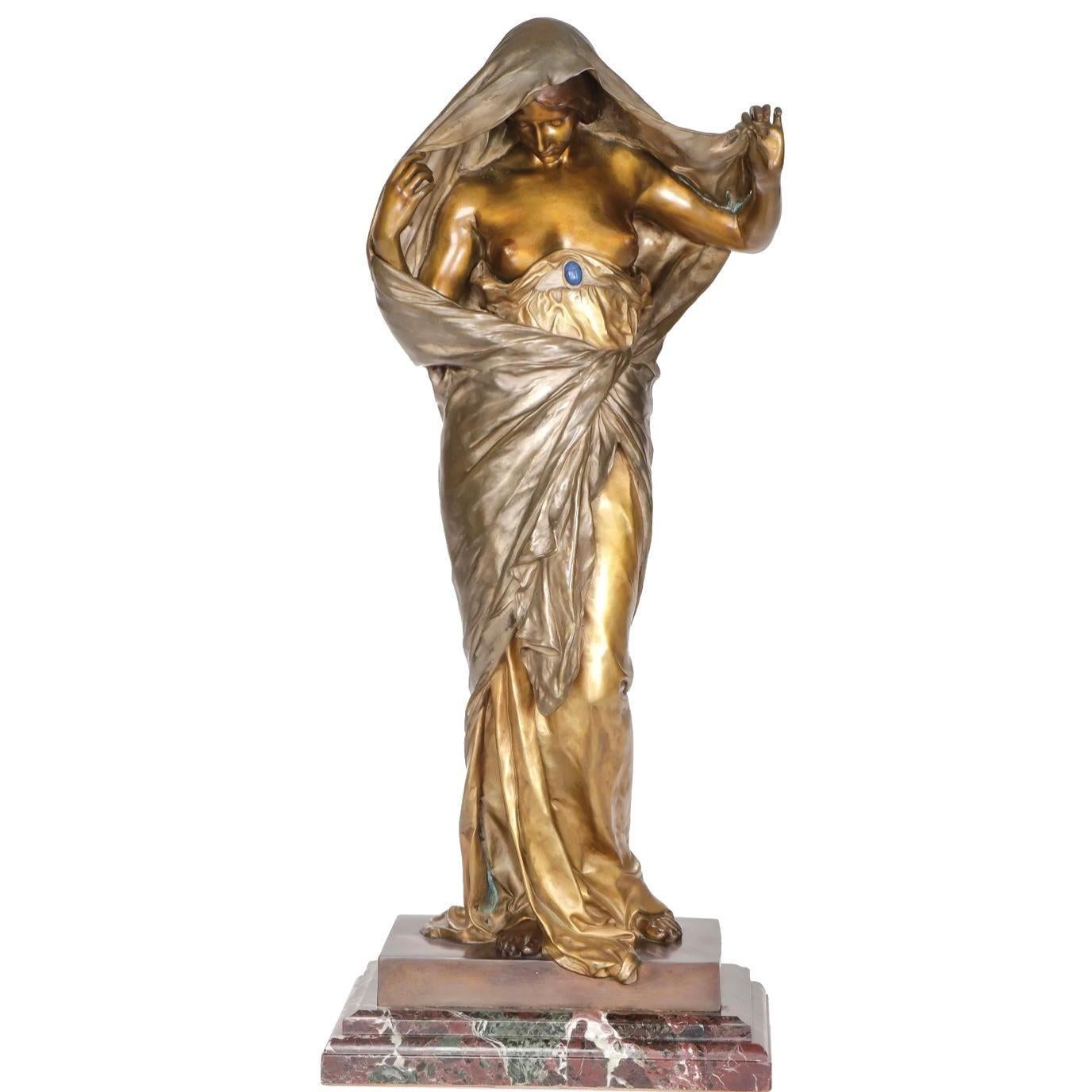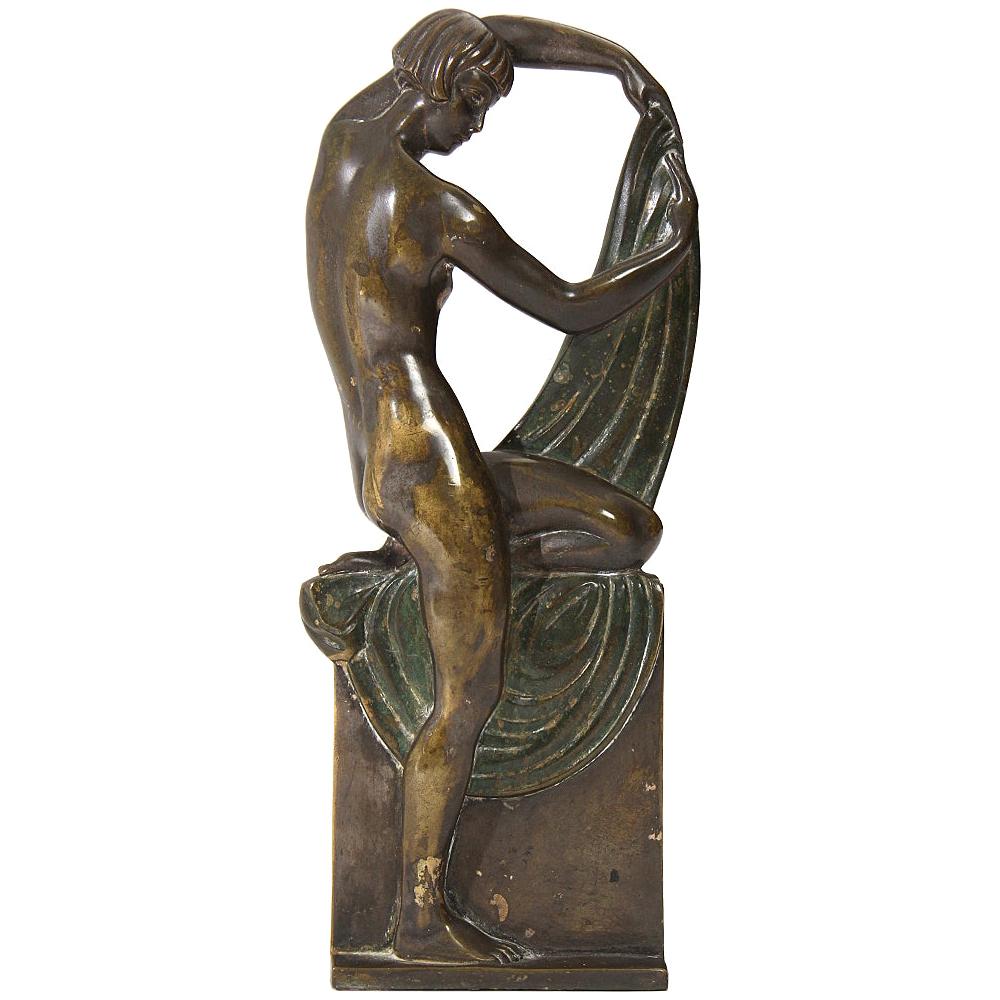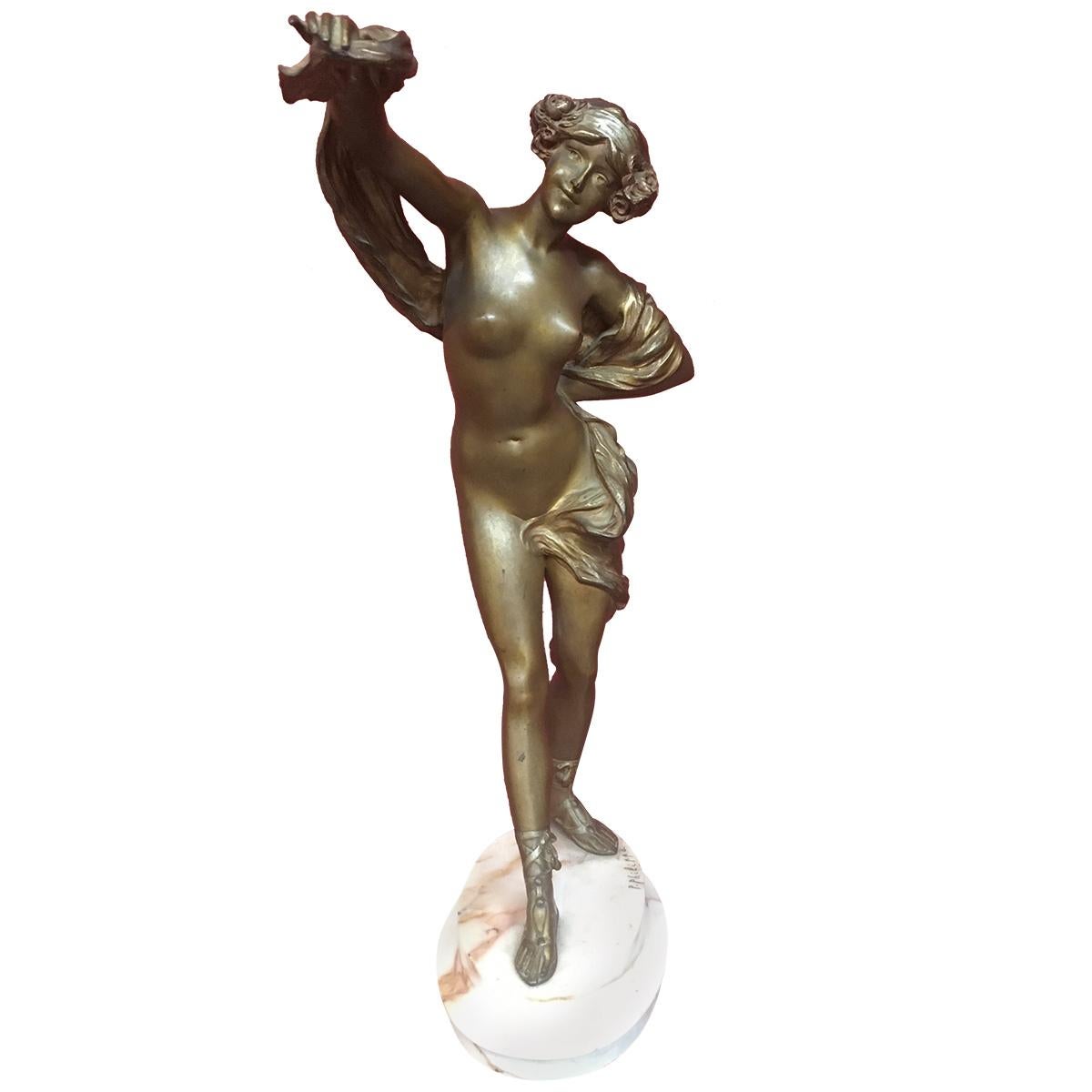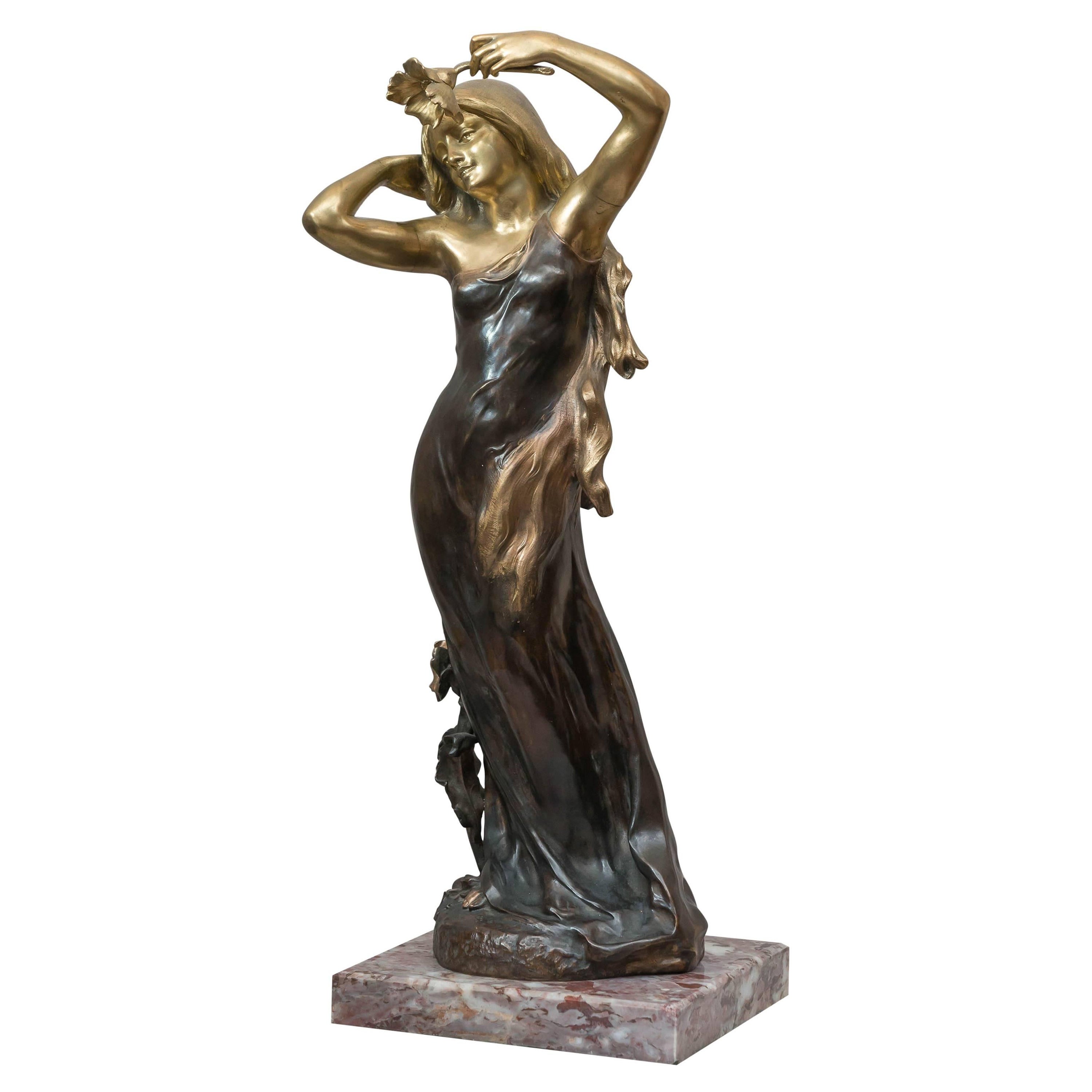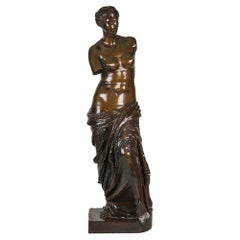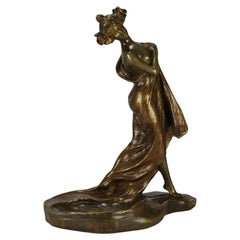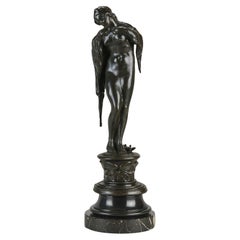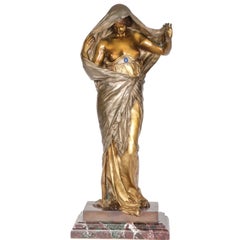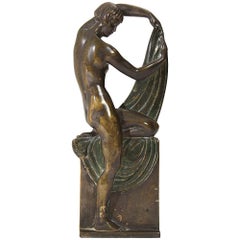Items Similar to Late 19th Century Art Nouveau Sculpture "Nature Unveiling" by Ernst Barrias
Want more images or videos?
Request additional images or videos from the seller
1 of 15
Late 19th Century Art Nouveau Sculpture "Nature Unveiling" by Ernst Barrias
$10,452.95
£7,550
€8,931.42
CA$14,386.65
A$15,964.13
CHF 8,420.69
MX$194,887.89
NOK 106,538.13
SEK 99,781.58
DKK 66,653.47
About the Item
Wonderful late 19th Century Art Nouveau French bronze figure of a seductively draped female figure representing, in allegorical form, Nature revealing her secrets to Science, a fitting theme for the late nineteenth century. The interest in nature literally apparent in the work of the Barbizon school and the Impressionists is here portrayed in the symbolic manner favoured by Salon sculptors. The erotic overtones of the figure's pose and the richly varied colours of the bronze surface are characteristic of the opulent taste of the late nineteenth century, while the flowing linear patterns of the drapery and the curving outline of the figure suggest the forms of Art Nouveau.
This fine sculpture is cast in bronze and highlighted in a silver and gilded finish enhancing the textural surface of the subject. Raised on an integral bronze base, signed E Barrias and with Susse Freres foundry stamp and further inscription.
ADDITIONAL INFORMATION
Height: 27 cm
Width: 11 cm
Depth: 8 cm
Circa: 1900
Condition: Excellent original condition
Foundry: Susse Freres Paris
Materials: Bronze
SKU: 9345
ABOUT
Louis Ernest Barrias (French, 1841 ~ 1905) was born in Paris into a family of artists. His father was a porcelain-painter, and his older brother Félix-Joseph Barrias a well-known painter. Louis Barrias also started out as a painter, studying under Léon Cogniet, but later took up sculpture with Pierre-Jules Cavelier as teacher. In 1858 he was admitted to the École nationale supérieure des Beaux-Arts in Paris, where his teacher was François Jouffroy. In 1865 Barrias won the Prix de Rome for study at the French Academy in Rome. Barrias was involved in the decoration of the Paris Opéra and the Hôtel de la Païva in the Champs-Élysées. His work was mostly in marble, in a Romantic realist style indebted to Jean-Baptiste Carpeaux.
In 1878 he was made a knight of the Legion of Honour, an officer in 1881, and a commander in 1900. Barrias replaced Dumont at the Institut de France in 1884 then succeeded Cavelier as professor at the École des Beaux-Arts. In 1900-03 he served on the Council for the National Museums. Among his students were Josep Clarà, Charles Despiau, Henri Bouchard, and Victor Segoffin. Louis Barrias was very influenced by the Art Nouveau style, which was prominent in art during the fin-de-sidle in France. The voluptuous women figures used in many of his sculptures are a product of this time and style. Nature and the erotic was, also, used often in this type style of art, which is seen in many of Barrias’s works including, “Nature Unveiling Herself Before Science.” This piece was made in 1899, when this style was popular.
Nature Unveiling Her Secrets to Science by Louis Barrias
The statue was commissioned in 1889 to decorate the new medical school in Bordeaux. A young woman, the allegory of nature, is slowly lifting the veils she is wrapped in. When he had finished the first version in white marble for the school, Barrias designed a second statue in polychrome, for the ceremonial staircase of the Conservatoire des Arts et Métiers, in Paris. He used marble and onyx from the newly reopened quarries in Algeria.
Carefully carved to enhance the decorative qualities of the materials, the various parts of the statue play on the veins in the ribboned onyx for the veil, the mottled effect of the red marble for the robe, the preciousness of lapis lazuli for the eyes and malachite for the scarab and coral for the mouth and lips.The overall effect is surprisingly rich. The work belongs to a major revival of polychrome sculpture launched by archaeological discoveries and illustrated fifty years earlier by Cordier.
- Dimensions:Height: 10.63 in (27 cm)Width: 4.34 in (11 cm)Depth: 3.15 in (8 cm)
- Style:Art Nouveau (Of the Period)
- Materials and Techniques:
- Place of Origin:
- Period:
- Date of Manufacture:1900
- Condition:Wear consistent with age and use.
- Seller Location:London, GB
- Reference Number:Seller: 93451stDibs: LU3216344941182
About the Seller
5.0
Vetted Professional Seller
Every seller passes strict standards for authenticity and reliability
Established in 1936
1stDibs seller since 2017
84 sales on 1stDibs
Typical response time: 1 hour
- ShippingRetrieving quote...Shipping from: London, United Kingdom
- Return Policy
Authenticity Guarantee
In the unlikely event there’s an issue with an item’s authenticity, contact us within 1 year for a full refund. DetailsMoney-Back Guarantee
If your item is not as described, is damaged in transit, or does not arrive, contact us within 7 days for a full refund. Details24-Hour Cancellation
You have a 24-hour grace period in which to reconsider your purchase, with no questions asked.Vetted Professional Sellers
Our world-class sellers must adhere to strict standards for service and quality, maintaining the integrity of our listings.Price-Match Guarantee
If you find that a seller listed the same item for a lower price elsewhere, we’ll match it.Trusted Global Delivery
Our best-in-class carrier network provides specialized shipping options worldwide, including custom delivery.More From This Seller
View AllEarly 20th Century Art Nouveau Bronze Entitled "La Jeuneuse" by Antonin Carlès
By Antonin Carlès
Located in London, GB
A delightful Art Nouveau early 20th Century gilt bronze figure of a very beautiful young lady holding a flower in her right hand, the surface of the bronze exhibiting fine detail and...
Category
Antique Early 1900s French Art Nouveau Figurative Sculptures
Materials
Bronze
Late 19th Century Art Nouveau Sculpture "Venus de Milo" by F. Barbedienne
By F. Barbedienne Foundry
Located in London, GB
A large and impressive late 19th Century bronze study of the famous Venus de Milo sculpture of antiquity with excellent rich brown patina and good hand finished surface detail, inscribed F.Barbedienne foundry
ADDITIONAL INFORMATION
Height: 95 cm
Width: 28 cm
Depth: 28 cm
Condition: Excellent Original Condition
Circa: 1890
Materials: Bronze
Foundry: F.Barbedienne
SKU: 7741
ABOUT
The Barbedienne Foundry is a famous 19th century bronze foundry, whose statues and art objects became rapidly very renowned. This bronze studio co-worked with other trades, and put his name to a great variety of works, such as furnishing in particular. Attending every World's Fair of its time, the Barbedienne Foundry was regularly awarded, notably at the World's Fair of 1855 where it was awarded the Great Medal of Honor.
A Parisian bronze maker and caster, Ferdinand Barbedienne (1810-1892) creates a firm in 1839 in collaboration with Achille Collas, the inventor of the mechanical method to obtain copies of sculptures at a smaller scale. With this groundbreaking proceed, they facilitated an unprecedented production. Under the “Collas et Barbedienne” name, they specialized in Antiquity copies and perfected new chemical methods for the color and patina finish of their bronzes. As a true Romantic, Ferdinand Barbedienne is committed to democratization of arts, he thus realizes numerous Antiquity copies and stimulates his contemporaries’ works broadcasting. A great deal of famous sculptures are hence cast by the Barbedienne Foundry. All his life, Barbedienne co-worked with the greatest artists, sculptors or designers of his time, such as Edouard Lievre, Ferdinand Levillain, Attarge, Aizelin, Barye or Fremiet.
Statues aside, he products a great deal of decorative artifacts, such as clocks, vases, mirrors, etc. Since 1855, Ferdinand Barbedienne collaborates with the famous decoration designer Louis-Constant Sévin (1821-1888). Joining the firm as a sculptor-designer, he stays loyal to it his life long, always finding more new designs for daily objects, which hence become true art works. Sevin’s creations, specialized in the “Neo-Greek” style, were particularly appreciated for antiquity reference in decorative arts, just like the great mirror preserved by the Orsay Museum. He also teams up with enamelers including Alfred Serre, and develops a set of “cloisonnés” enamels that made the headlines at the World's Fair of 1862 in London, which was the very beginning of the art of enamel’s return. In collaboration with Serre, Barbedienne realized between 1878 and 1889 the Monumental Clock in Renaissance style, decorated with enamels, which is preserved in the Paris City Hall.
Venus de Milo
Facts about Venus de Milo sculpture.
For much of the world, the mystery of the Venus de Milo lies in her missing arms. But there’s much more to this iconic statue than a couple of absent appendages.
1. Venus de Milo‘s title is a bit misleading.
It’s popularly believed that this Grecian statue depicts the Greek Goddess of love and beauty, who was often rendered half-naked. However, the Greeks would have called this deity Aphrodite. Nonetheless, the Roman-inspired Venus de Milo caught on.
2. She’s named in part for where she was discovered.
On April 8, 1820, a farmer named Yorgos Kentrotas came across the statue in pieces within the ruins of an ancient city on the island of Milos (formerly known as Melos).
3. Alexandros of Antioch is credited with her creation.
A sculptor of the Hellenistic period, Alexandros is believed to have carved this masterpiece between 130 and 100 BCE. The inscription on the plinth—the slab on which the statue rested—that identified him as Venus de Milo‘s creator was lost nearly 200 years ago.
4. She might not be Venus.
Some have suggested the sculpture is not Aphrodite/Venus, but Amphitrite, the sea goddess who was particularly adored on Milos. Still others have proposed she’s Victory, or perhaps a prostitute. With her arms long missing, would-be context clues have been lost for centuries. A spear could have meant one thing, a spool of thread another. If she held an apple—as some reports claim—it could mean she was Aphrodite, holding the award given to her by Paris before the Trojan War began. To this day, it’s a matter of passionate debate.
5. She became a gift to the King of France.
When Kentrotas called upon a French naval officer to help him unearth the spectacular sculpture, he began a chain of events that would eventually lead to the Marquis de Rivière presenting Venus de Milo to Louis XVIII. In turn, the ruler gave the statue to the Louvre, where it is on display to this very day.
6. The loss of her limbs is the fault of the French.
Kentrotas did find fragments of an arm and a hand when he uncovered the statue in the ruins, but as Venus de Milo was being reassembled, those arms were discarded for having a “rougher” appearance. Modern art historians believe that the variation of finish does not mean those arms did not belong to Venus, but both the arms and the original plinth have been lost since the piece moved to Paris in 1820.
7. The original plinth was ditched on purpose.
Sight unseen, early 19th century art historians decided the newly discovered Venus must have been the work of Greek artist Praxiteles, and publicized the work as such. This attribution would have placed the piece in the Classical period (5th through 4th centuries BCE), which was more respected artistically than the Hellenistic period. To save face and better promote Venus de Milo—even at the cost of misinforming the public—the plinth was removed before it was presented to the King.
8. Venus de Milo was meant to make up for a national embarrassment.
During his conquests, Napoleon Bonaparte had plundered one of the finest examples of Greek sculpture, Venus de’ Medici, from Italy. In 1815, the French government returned that beloved sculpture, but in 1820, France embraced the chance to fill the hole its absence left in the French culture and national pride. As such, Venus de Milo was promoted as being even greater than Venus de’ Medici upon her Louvre debut. The ploy worked, and the piece was met with almost universal praise from artists and critics.
9. Renoir was not impressed.
Perhaps the most famous of Venus de Milo‘s detractors, the celebrated Impressionist painter dismissed this delicate depiction of grace and female beauty as “a big gendarme.”
10. She went into hiding during World War II.
By the autumn of 1939, war threatened to descend on Paris, so Venus de Milo along with some other priceless pieces, such as Winged Victory of Samothrace and Michelangelo’s Slaves, were whisked away for safekeeping at various châteaux in the French countryside.
11. She’s been robbed!
Venus is missing more than just her arms. She was originally draped in jewellery including a bracelet, earrings and a headband. These flourishes are long lost, but the holes for fixing them to the piece remain in the marble, giving clues to the missing accessories.
12. She lost her colour.
While it’s easy for today’s art admirers to think of Greek statues as white, the marble was often painted in the style of polychromy. However, no trace of the original paint scheme remains on Venus de Milo today.
13. She’s taller than most people.
Even with her slight slouch, Venus de Milo stands at 6 feet 8 inches tall.
14. She could be a copy.
Art historians have noted that Venus de Milo bears a striking resemblance to Aphrodite of Capua, which is a Roman era copy of a possibly late 4th century BCE bronze Greek original. That would be at least 170 years before Alexandros carved his goddess, leading some to speculate that both statues are actually replicas of an older statue...
Category
Antique Late 19th Century French Art Nouveau Figurative Sculptures
Materials
Bronze
Late 19th Century Art Nouveau Bronze "Nouveau Lady" by Georges Van Der Straeten
By Georges Van der Straeten
Located in London, GB
A delightful Art Nouveau Bronze figure of a young beauty scantily dressed with only a shawl draped across her body in a striking pose. The surface of the bronze with rich golden/brow...
Category
Antique Late 19th Century Belgian Art Nouveau Figurative Sculptures
Materials
Bronze
Late 19th Century Art Nouveau Sculpture "Girl in Cloak" by Vernon March
Located in London, GB
An excellent late 19th Century patinated Art Nouveau bronze study of a naked beauty standing on a podium with a cape draped over her shoulders, raised on a marble plinth and signed
...
Category
Antique Late 19th Century English Art Nouveau Figurative Sculptures
Materials
Bronze
Early 20th Century Art Deco Sculpture entitled "Printemps" by Joe Descomps
By Joe Descomps Cormier
Located in London, GB
An entrancing Art Deco cold painted gilt bronze figure of a naked beauty wearing an oversized coat loosely draped to show her attractive figure, the bronze with excellent colour and ...
Category
Early 20th Century French Art Deco Figurative Sculptures
Materials
Bronze
"Delicate" by Paul Philippe
By Paul Philippe
Located in London, GB
An excellent French early 20th Century Art Deco bronze figure of a young attractive naked woman in an elegant pose with rich brown patination, raised on fitted green marble base & si...
Category
Early 20th Century French Art Nouveau Figurative Sculptures
Materials
Marble, Bronze
You May Also Like
Louis Ernest Barrias Nature Revealing Herself
By Louis Ernest Barrias
Located in Dallas, TX
Louis Ernest Barrias (French 1841-1905)
Nature Revealing Herself
La Nature se dévoilant devant la Science
Gilt, and silver patinated bronze with blue glass scarab
Signed on base “E...
Category
Early 1900s Art Nouveau Figurative Sculptures
Materials
Bronze
Bronze Art Nouveau Sculpture from France
Located in Sagaponack, NY
A cast bronze sculpture with original markings. Stamped "Made in France" "LN PARIS JR".
Category
Early 20th Century French Art Nouveau Sculptures
Materials
Bronze
Maurice Bouval Bronze Art Nouveau
By Maurice Bouval
Located in NANTES, FR
Maurice Bouval bronze with gilded patina signed M.Bouval and stamp of founder on a marble base portor.
Length: base 11 cm
Depth: 9,6 cm
Height: 30,...
Category
Early 20th Century French Art Nouveau Figurative Sculptures
Materials
Marble, Bronze
Paul Philippe ( 1870-1930) Art Nouveau Sculpture in Bronze, Signed on Marble
By Paul Philippe
Located in Saint-Ouen, FR
Paul Philippe (1870-1930) Art Nouveau sculpture in bronze, signed on marble.
Category
Early 20th Century European Art Nouveau Figurative Sculptures
Materials
Marble, Bronze
Art Nouveau Bronze Figure of a Young Woman
By Henryk Kossowski Jr. 1
Located in Petaluma, CA
For the art nouveau lover, this is certainly worth one to ponder, for all others, here is fine example art nouveau. The two color patina makes this very desirable. Her beautiful gold...
Category
Antique 1890s French Art Nouveau Figurative Sculptures
Materials
Marble, Bronze
Henri Godet "L'Aurore" Patinated Bronze Sculpture
By Henri Godet
Located in Astoria, NY
Henri Godet (French, 1863-1937) "La Reveil de L'Aurore" [The Awakening of Dawn] Patinated Bronze Sculpture, early 20th century, on a circular base with applied plaque "La Reveil de L...
Category
Early 20th Century French Art Nouveau Figurative Sculptures
Materials
Bronze
